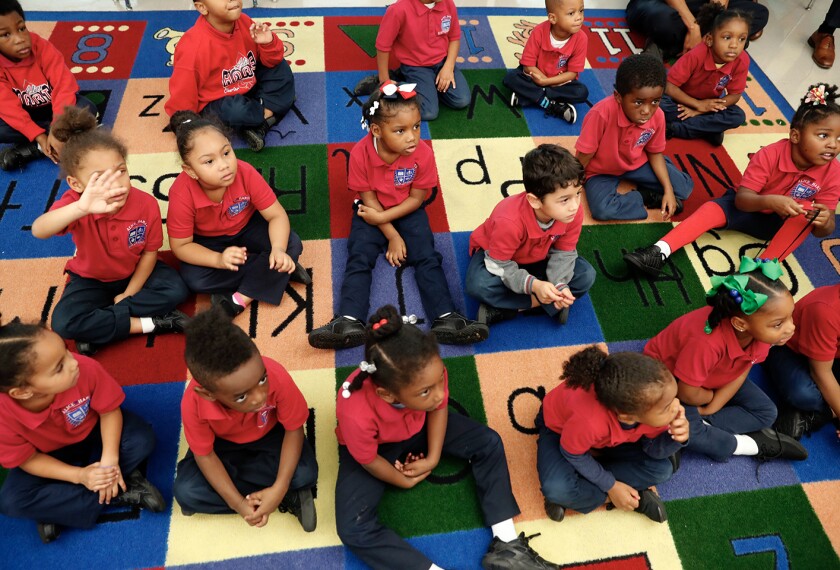Everything has come to a screeching halt. Our preschool, normally alive with children belting out their morning circle time songs, has become eerily quiet. The end-of-the-day fogging to disinfect the building has left a dull film that now covers the brightly colored toys. Students’ artwork and a few of our teachers’ materials are still scattered around, giving the impression that we were coming back the next day. We couldn’t have been more wrong.
COVID-19 has shut down our preschool for an indefinite length of time. We now are faced with a dilemma: How do we support our youngest learners during this time?
In just a few days after the school closure announcement last month, the internet exploded with creative ways to cultivate learning communities. The problem was that the resources provided are not meant for young students. It was clear to us that learning and progress will look very different in the preschool setting.
Our school, like many other preschools across the country, had a strict no-technology policy. Many studies on children’s brain development have discouraged the use of technology for young learners. Excessive technology time for young children has shown a decrease in their critical-thinking skills, imagination, and attention span.
However, these are unprecedented times. We have had to force ourselves to adjust and adopt ways to use technology. To do this, we asked ourselves a set of guiding questions to come up with a plan to respond to the changes preschool students are facing:
One of our students brushed his teeth and got dressed because he thought he was going back to school to see his classmates."
1. How will our content remain relevant (is it still relevant?), developmentally appropriate, and student-centered?
2. How are we being sensitive to our parents, who are working at the same time while they teach their little ones? How do we adequately support both parents and the student? What does support look like to them?
3. How can we, as early-childhood educators, use this time to let go of our pre-COVID-19 notions of how our students learn and bravely embrace a new way of doing things?
We had to start by accepting that learning has shifted out of the preschool building. We’ve decided to leave all the curriculum goals and expectations behind. The preschool teacher is no longer there to sit crisscross applesauce with the students during circle time. There are no more guiding hands teaching scissor skills. Parents are now working from home and instructing the students at the same time: Progress will undoubtedly look different.
To that end, when we shuttered our doors, we started offering an optional 10-minute circle time with our students over Zoom. We talk about the day and the weather, have them sing their favorite songs, and engage them with a quick story. We had one teacher use a photo of her classroom as her backdrop to help the students see that their classroom is still around. Our yoga teacher also shifted her class online through Zoom. The children can participate in daily yoga classes to get their wiggles out.
Virtual circle time confused a couple of students the first time we did it. They were not used to seeing their classmates housed on a screen. One of our students brushed his teeth and got dressed because he thought he was going back to school to see his classmates. He was inconsolable during the first few minutes of the session when he realized that was not the case.
There is absolutely no pressure for the parents to log on, but almost all our families have been. We had a parent comment that being a teacher to her 3-year-old and working from home was just too much. She welcomed the 10-minute reprieve, when she was not the sole facilitator of entertainment and learning for her child.
We have also encouraged parents to share pictures and interact with other families using the free app Seesaw. It has been an invaluable way for our teachers and families to stay connected during this pandemic. Our parents have found it comforting, knowing they are not alone in their struggles. One mom shared that she brought out all her Christmas decorations and had her child play with the nativity scene. Her child has now used it as a dramatic playset. “Whatever works! I am not sure how the preschool teachers do it and I only have one child!” another parent commented underneath the mom’s post.
Our teachers have been using Google Docs as well, to upload various links, resources, and even their lesson plans to share with the children’s families. Parents can comb through these resources and continue classroom routines in their homes if their schedules permit. However, Google Docs is probably the least-used resource among our parents. With some of our parents just trying to survive, this is not something that everyone has time to explore.
Beyond the virtual-learning world, we have also turned to snail mail to connect with our students. We took materials out of our classrooms (sanitized, of course!) and mailed them to our students. These activity packets consisted of Play-Doh, storybooks, and a few learning manipulatives that the children can use while at home.
Our preschool life feels like a push to create normalcy during a global reset. The methods we are using to teach preschoolers are unorthodox. Months ago, I would say learning this way would be against our “learning through play” creed.
Even if this pandemic is temporary, it has brought about permanent changes. It may feel like the nadir of our teaching careers when we miss out on witnessing our students’ milestones, but the crisis has challenged our traditional ways of thinking about the preschool field. Our goal has now shifted from providing an exceptional early-learning environment for our students to ensuring that parents have the necessary tools to support their children through this time. Our classrooms and playgrounds are now empty, but learning continues, just in a different space.




